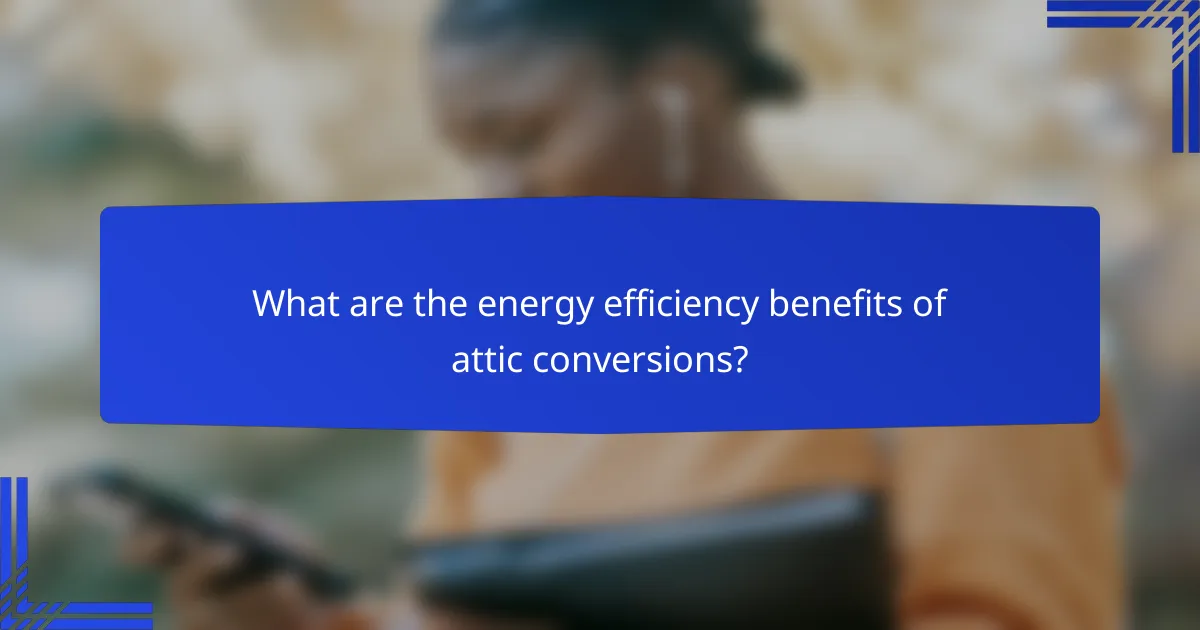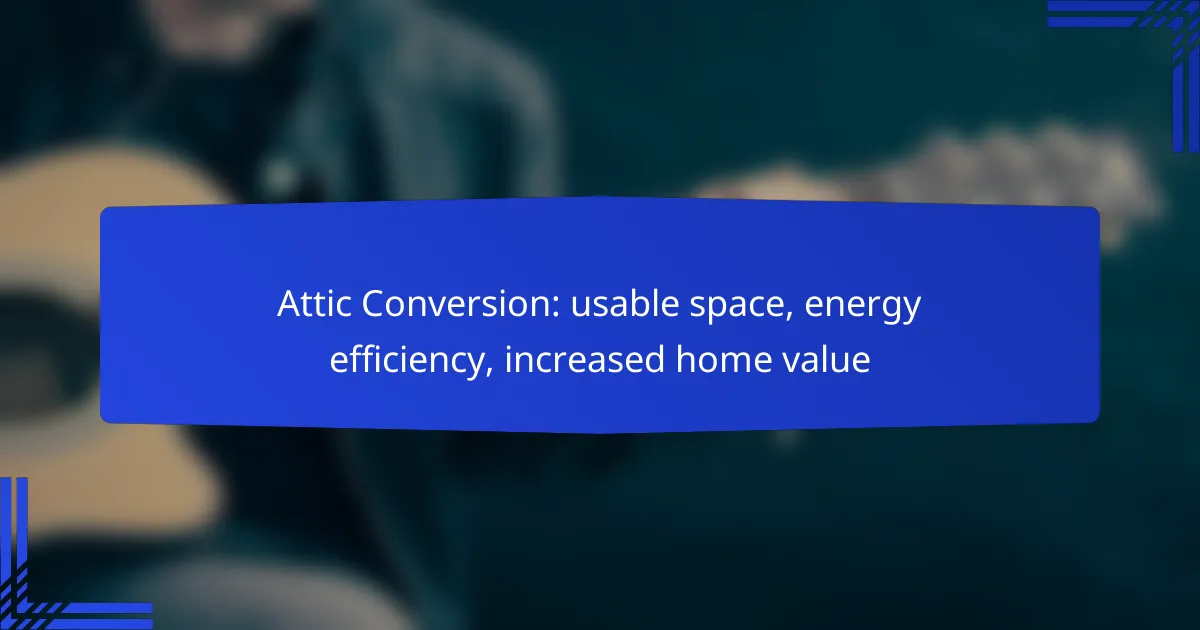An attic conversion is an excellent way to maximize the usable space in your home, transforming an underutilized area into a functional living environment. This upgrade not only enhances energy efficiency through improved insulation and natural light but also significantly boosts your property’s market value, making it more appealing to potential buyers.

How can an attic conversion create usable space in London homes?
An attic conversion can significantly enhance the usable space in London homes by transforming an often neglected area into functional living space. This process not only adds square footage but can also improve the overall layout and utility of the home.
Maximizing floor area
To maximize floor area in an attic conversion, consider the pitch of the roof and the layout of the existing structure. A well-planned design can utilize sloped ceilings effectively, allowing for more usable space without compromising the overall aesthetic. Aim for a minimum head height of around 2.2 meters for comfort and usability.
Incorporating dormer windows can also enhance floor area by creating vertical space and allowing natural light to flood in. This can make the area feel larger and more inviting, which is particularly valuable in compact London homes.
Creating additional rooms
An attic conversion can be an excellent way to create additional rooms, such as a bedroom, home office, or playroom. By carefully planning the layout, you can designate specific areas for different functions, maximizing the utility of the space. Consider open-plan designs to maintain a sense of spaciousness.
When designing these new rooms, ensure compliance with local building regulations, including fire safety and insulation standards. This will not only enhance safety but also improve energy efficiency, making the new space more comfortable year-round.
Improving storage solutions
Attics often present unique storage challenges due to their shape and size. However, a conversion can incorporate clever storage solutions, such as built-in cabinets or under-eave storage, which can help keep the space organized and clutter-free. Utilize vertical space with shelving and consider multi-functional furniture to maximize storage.
Incorporating storage into the design can significantly enhance the functionality of the converted attic, making it a practical addition to your home. This is particularly beneficial in London, where space is at a premium and efficient storage solutions can greatly improve daily living.

What are the energy efficiency benefits of attic conversions?
Attic conversions can significantly enhance energy efficiency by improving insulation, reducing heating costs, and maximizing natural light. These benefits not only create a more comfortable living space but also contribute to lower energy bills and increased home value.
Enhanced insulation
Proper insulation is crucial in an attic conversion, as it helps maintain a consistent temperature throughout the home. By using high-quality insulation materials, homeowners can prevent heat loss during colder months and keep the space cooler in summer. Consider insulation types such as spray foam, fiberglass batts, or rigid foam boards, which can provide effective thermal resistance.
When planning insulation, ensure it meets local building codes and energy efficiency standards. A well-insulated attic can reduce energy consumption by up to 20-30%, making it a worthwhile investment for long-term savings.
Lower heating costs
With improved insulation, homeowners often experience lower heating costs. An attic conversion can help seal drafts and reduce the workload on heating systems, leading to significant savings on energy bills. In many cases, homeowners report a reduction of 10-15% in heating expenses after completing an attic conversion.
To maximize savings, consider installing energy-efficient heating systems, such as ductless mini-split systems or radiant floor heating, which can provide targeted warmth without excessive energy use.
Utilizing natural light
Incorporating windows or skylights in an attic conversion can enhance energy efficiency by utilizing natural light. This reduces reliance on artificial lighting, which can lower electricity costs. Strategically placed windows can also improve ventilation, contributing to a healthier indoor environment.
When selecting windows, opt for energy-efficient models that are double or triple-glazed to minimize heat transfer. This not only enhances comfort but can also qualify for local energy efficiency rebates or tax incentives, further improving the financial benefits of your attic conversion.

How does an attic conversion increase home value in the UK?
An attic conversion can significantly enhance a property’s value in the UK by adding usable living space and improving overall market appeal. This transformation not only makes the home more attractive to potential buyers but also increases its functional square footage, which is a key factor in property valuation.
Higher property market appeal
Converting an attic into a functional living area can make a property stand out in a competitive market. Buyers often seek homes with additional bedrooms, offices, or playrooms, and an attic conversion can fulfill these needs without requiring a full extension. This added appeal can lead to quicker sales and potentially higher offers.
Moreover, a well-executed attic conversion can enhance the aesthetic of the home, making it more inviting. Features like skylights or open-plan designs can create a bright and airy atmosphere, further increasing its desirability.
Return on investment statistics
The return on investment (ROI) for attic conversions in the UK can be substantial, often ranging from 20% to 30% or more. This means that homeowners can recoup a significant portion of their conversion costs when selling their property. Factors influencing ROI include the quality of the conversion, the local property market, and the overall demand for housing in the area.
Investing in energy-efficient solutions during the conversion can also improve ROI. Features such as proper insulation and energy-efficient windows not only enhance comfort but can lower utility bills, making the property more attractive to eco-conscious buyers.
Comparative property values
Properties with attic conversions typically command higher prices compared to similar homes without such enhancements. In many areas, the difference can be tens of thousands of pounds, depending on the quality and size of the conversion. For instance, a three-bedroom house with a converted attic may sell for significantly more than a similar three-bedroom house without that extra space.
Additionally, the value added by an attic conversion can vary by region. In urban areas where space is at a premium, the increase in property value can be even more pronounced, making it a worthwhile investment for homeowners looking to maximize their property’s worth.

What are the key considerations before starting an attic conversion?
Before starting an attic conversion, it’s essential to consider building regulations, planning permission, and structural assessments. These factors ensure that the conversion is safe, legal, and adds value to your home.
Building regulations in the UK
In the UK, building regulations set the standards for construction and safety in attic conversions. These regulations cover aspects such as fire safety, insulation, and structural integrity. Compliance is crucial to ensure the safety of the new space and to avoid potential legal issues.
Common requirements include proper stair access, adequate ventilation, and energy efficiency standards. It’s advisable to consult with a qualified builder or architect familiar with local regulations to ensure compliance.
Planning permission requirements
Planning permission may be required for attic conversions, depending on the extent of the work and the property’s location. In many cases, if the conversion falls within permitted development rights, you may not need to apply for planning permission. However, significant alterations or changes to the roofline typically require approval.
It’s essential to check with your local planning authority to determine specific requirements for your area. Engaging with them early in the process can help avoid delays and ensure a smoother conversion.
Structural assessments
A structural assessment is vital to determine if your attic can support the intended conversion. This evaluation should include checking the existing roof structure, walls, and floor joists for stability and strength. An engineer or qualified builder can conduct this assessment.
Addressing any structural issues before starting the conversion can save time and money in the long run. If significant reinforcements are needed, factor these costs into your budget to avoid unexpected expenses during the project.

Which design styles are popular for attic conversions?
Popular design styles for attic conversions include modern minimalist, traditional loft aesthetics, and functional workspace layouts. Each style offers unique benefits and considerations that can enhance the usability and appeal of the converted space.
Modern minimalist designs
Modern minimalist designs focus on simplicity and functionality, often featuring clean lines and a neutral color palette. This style maximizes space by minimizing clutter and using multi-functional furniture, making it ideal for smaller attic areas.
Key elements include large windows for natural light, open floor plans, and minimal decorative items. Consider incorporating built-in storage solutions to maintain a tidy appearance while enhancing usability.
Traditional loft aesthetics
Traditional loft aesthetics embrace rustic charm with exposed beams, brick walls, and vintage furnishings. This style creates a warm, inviting atmosphere that retains the character of the original attic space.
To achieve this look, focus on using reclaimed materials and vintage decor. Mixing modern and traditional elements can create a unique balance, but be cautious not to overcrowd the space with too many contrasting styles.
Functional workspace layouts
Functional workspace layouts prioritize practicality, making them suitable for home offices or study areas. These designs often include dedicated zones for work, storage, and relaxation, ensuring that the attic serves multiple purposes.
When planning a workspace, consider ergonomic furniture and adequate lighting. It’s essential to maintain a clear distinction between work and leisure areas to enhance productivity and comfort.

What are the costs associated with attic conversions in England?
The costs of attic conversions in England can vary widely based on factors like location, design, and the extent of the work required. Generally, homeowners can expect to spend anywhere from £20,000 to £50,000, depending on the complexity of the project and the materials used.
Average construction costs
Average construction costs for attic conversions typically range from £30,000 to £50,000. This includes structural work, insulation, and finishing touches. The final price can be influenced by the type of conversion, such as a dormer or a roof lift, with dormer conversions often being more affordable.
Additionally, costs may increase if planning permission is needed or if the existing structure requires significant reinforcement. Always obtain multiple quotes from contractors to ensure competitive pricing.
Potential financing options
Homeowners can explore various financing options for attic conversions, including personal loans, home equity loans, and remortgaging. Personal loans typically offer quick access to funds but may come with higher interest rates.
Home equity loans allow homeowners to borrow against the value of their property, often at lower rates. Remortgaging can provide a larger sum but may involve additional fees and a longer process. It’s advisable to consult a financial advisor to determine the best option based on individual circumstances.
Cost-saving tips
To save on attic conversion costs, consider doing some of the work yourself, such as painting or installing fixtures. This can significantly reduce labor expenses. Additionally, sourcing materials from local suppliers or opting for budget-friendly finishes can help keep costs down.
It’s also wise to plan carefully and avoid changes mid-project, as alterations can lead to increased costs. Finally, check for any available grants or incentives for energy-efficient upgrades, which can offset some expenses.
